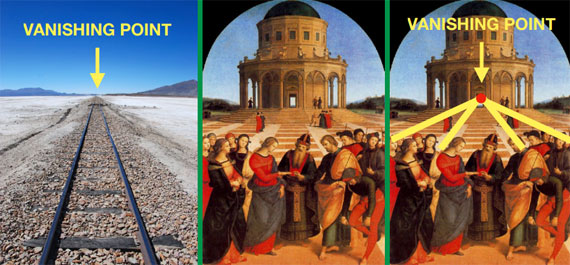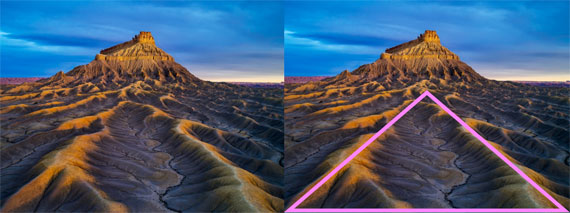Vanishing points are a fundamental concept in photography that can significantly enhance the depth and realism of your images. Understanding how to use them effectively can transform your compositions, drawing the viewer’s eye into the photograph and creating a sense of three-dimensional space.
Today’s lesson is based on concepts from Visual Flow, the Ultimate Photography Composition Course by Ian Plant, it is currently $25 off today if you want to check it out.

What is a Vanishing Point?
A vanishing point is the point in the distance where objects become too small to see clearly and appear to converge. This concept is easily illustrated by railroad tracks. Despite being parallel, when you look down a set of tracks, they seem to converge to a point at the horizon. This point is known as the vanishing point, and it plays a crucial role in implying depth in a photograph.
Historical Context
The concept of the vanishing point revolutionized perspective in art during the Renaissance. Great masters like Raphael used vanishing points to create depth and realism in their paintings. By understanding that parallel lines appear to converge at a single point as they recede into the distance, artists could create more lifelike and compelling compositions.
The Power of Vanishing Points
Vanishing points are powerful because they rivet the eye, compelling it to travel deep into the image. According to Gestalt principles, the human eye naturally follows a line to its conclusion, even if the line has ended. This makes the vanishing point a focal area where multiple lines in a composition converge, drawing the viewer’s attention and creating visual energy.
Using Vanishing Points in Photography
In photography, leading lines such as roads, rivers, or paths often create vanishing points. Even though these elements are made up of two lines or curves, they appear to converge in the distance, forming a vanishing point. When used effectively, these converging shapes can create depth and lead the viewer’s eye deep into the scene.

Photo captured by Ian Plant
For example, a curving stream flowing into the distance can create a vanishing point. This effect is reinforced by the convergence of lines formed by trees on both sides of the stream. The eye is inevitably drawn to the vanishing point, creating a sense of depth and movement in the image.
The Role of Triangles
Triangles naturally create vanishing points, as they lead the viewer’s eye from the foreground to the background. When two lines converge at a vanishing point and are mentally closed off at the bottom, they form a triangle. This shape is powerful in art and photography, helping to create depth and guiding the viewer’s eye through the composition.
Practical Tips for Using Vanishing Points
- Identify Leading Lines: Look for natural or man-made lines in your scene that lead toward the horizon. Roads, rivers, fences, and buildings are great examples.
- Centralize the Vanishing Point: Often, vanishing points work well when they are centrally located in the composition. This placement can create a balanced and harmonious image.
- Incorporate Triangles: Use triangular shapes to enhance the effect of the vanishing point. This can be done by positioning lines to form implied triangles that draw the eye into the image.
- Experiment with Different Heights: Vanishing points do not always need to originate from the bottom of the frame. They can be just as effective when they start higher up in the composition, as demonstrated by Renaissance paintings.
Conclusion
Mastering the use of vanishing points in photography can elevate your compositions, making them more engaging and dynamic. By understanding how to identify and utilize leading lines, triangles, and central placement, you can create images that draw viewers in and hold their attention. So next time you’re out shooting, keep an eye out for those converging lines and see how they can transform your photos.
For Further Training:
Hailed by customers and critics alike as the best resource available on explaining the secrets of making compelling photographic compositions, Ian Plant’s Visual Flow Course is designed to revitalize your photography. Currently $25 off today if you want to take a look.

Once you learn the visual design secrets of the great masters of art, it will change the way you see the world
Deal ending soon: Visual Flow Composition Course at 25% Off
- - - - - - - - - - - - - - - - - - - - - - - - - - - - - - - - - - - - - - - - - - - - - - - - - - - - - - - - - - - - - - - - - - - - - - - - - -
Photography, like any art or skill, thrives on consistency. The journey to becoming an adept photographer is paved with regular practice. Learn how PictureCorrect Insiders can help.
- - - - - - - - - - - - - - - - - - - - - - - - - - - - - - - - - - - - - - - - - - - - - - - - - - - - - - - - - - - - - - - - - - - - - - - - - -
This post Understanding Vanishing Point in Photography Composition appeared on PictureCorrect.
from PictureCorrect https://ift.tt/BOTfKhu
via IFTTT






0 kommenttia:
Lähetä kommentti